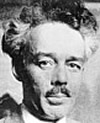LAWREN HARRIS
1885 - 1970
 Lawren
Harris was the artist singly most responsible for the formation of
The Group of Seven. A determined believer in the idea of a Canadian
art movement, he sought out J.E.H. MacDonald's acquaintance and was
influential in convincing A.Y. Jackson to move to Toronto. He lent
intellectual as well as financial support to fellow artists.
Lawren
Harris was the artist singly most responsible for the formation of
The Group of Seven. A determined believer in the idea of a Canadian
art movement, he sought out J.E.H. MacDonald's acquaintance and was
influential in convincing A.Y. Jackson to move to Toronto. He lent
intellectual as well as financial support to fellow artists.
Born in Brantford, Ontario, into a wealthy family, cofounders of the Massey-Harris farm machinery company, he was freed from the necessity of making a living and could concentrate on painting. His financial independence allowed him to make several important contributions to the development of the Group's new ideas. In 1913, with his friend Dr. James McCallum, he financed the construction of the still existing Studio Building on Severn Street in Toronto, providing artists with cheap or free space where they could live and work. It brought them closer to each other and the exchange of ideas must have been stimulating and encouraging for all. In 1918 and 1919 Harris financed two now-famous boxcar trips for artists to the Algoma region north of Sault Ste. Marie.
In his life and his painting Harris displayed an inclination toward the intellectual and the spiritual. Harris's painting into the early 1920's was characterized by rich, decorative colours applied in a thick painterly impasto. His subjects included the landscapes around Toronto and the rowhouses of that city's poorer streets, as well as Georgian Bay and, after the war, the Algoma region. In 1921, after an autumn painting trip to Algoma, Harris and Jackson continued on to Lake Superior's North Shore. The stark and monumental landscape of the North Shore corresponded to the direction that his paintings were moving and Harris was captivated. He returned to the area annually for the next seven years, developing the style for which he is now best known.
 Pic
Island of 1924 demonstrates his artistic concerns. The colour schemes
and composition reflect Theosophical symbolism, in which the purity
of truth is compared to a white ray of light; blues indicate various
states of religious feeling, and clarity of outline and shapes such
as the pyramid reflect the spiritual state. Lawren Harris was convinced
that art must express spiritual values as well as portraying the visible
world. To him, the role of artist and the function of art was to reveal
the divine forces in nature./p>
Pic
Island of 1924 demonstrates his artistic concerns. The colour schemes
and composition reflect Theosophical symbolism, in which the purity
of truth is compared to a white ray of light; blues indicate various
states of religious feeling, and clarity of outline and shapes such
as the pyramid reflect the spiritual state. Lawren Harris was convinced
that art must express spiritual values as well as portraying the visible
world. To him, the role of artist and the function of art was to reveal
the divine forces in nature./p>
Harris's search for "a deeper and more universal expression" took him farther afield not only geographically, but also artistically, eventually to a complete abstraction. His first visit to the Rockies was in 1924; it was a journey he repeated annually for the next three years. In 1930 he sailed for the Arctic with A.Y. Jackson aboard a supply ship. His paintings of the mountains and of icebergs show the realization of his painterly and religious ideals: the landscape is simplified to its basic forms, dominant and massive. In Mount LeFroy the diagonal lines of the mountain's shape draw the viewer's eye toward the white peak and the light surrounding it.
In 1934 Harris moved to the United States, first to New England and then to the Southwest. By 1940 he had settled in Vancouver. Harris's goal was to incorporate his spiritual feeling for the landscape into his work. After 1924 he no longer dated and signed his works because he did not want them to be tied to a specific artist or place. While Lawren Harris continued to explore new ideas, he also continued to be a driving force behind The Group of Seven.
Sources: The National Gallery and 'The McMichael Collection'